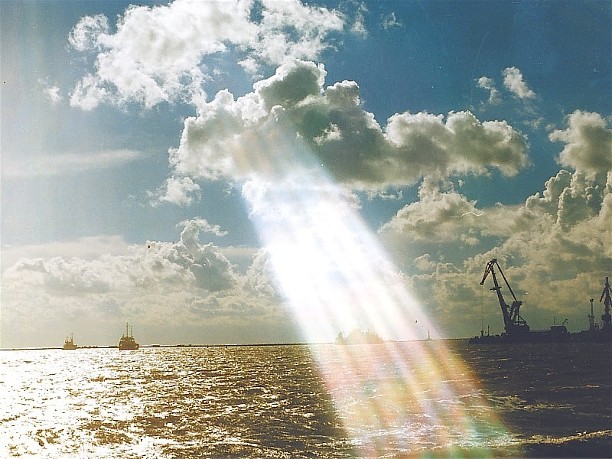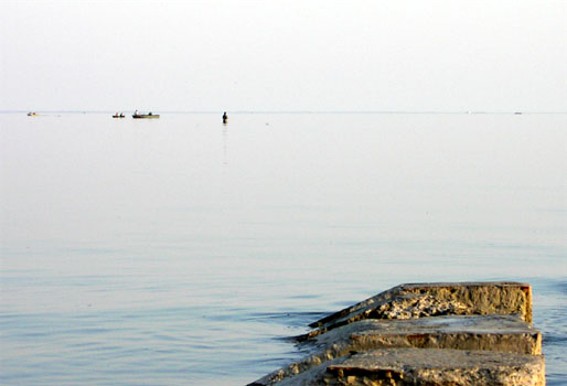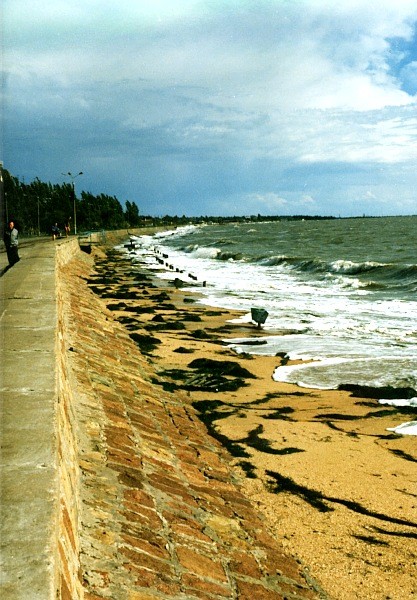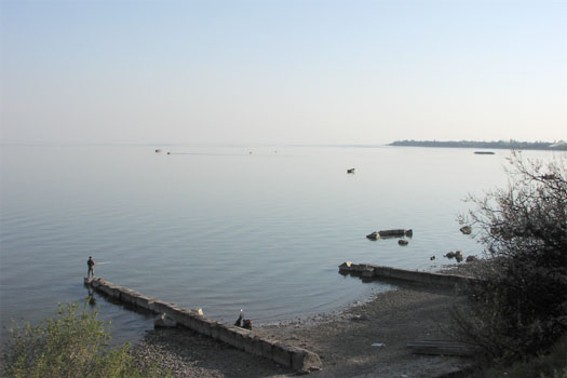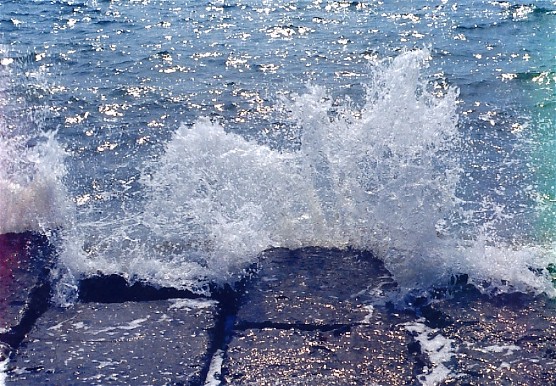Azov, Sea of
Azov, Sea of (Map: Sea of Azov) (Latin: Palus Maeotis; Greek: Μαιώτις [Maeotian Swamp or Maeotian Sea]; old Rus': Surozke more; Ukrainian: Ozivske more). A shallow branch of the Black Sea, connected to it by the Kerch Strait. It covers a part of the Black Sea Depression lying between the Donets Ridge and the Azov Upland in the north and the foothills of the Crimean Mountains and the Caucasus Mountains in the south. The Sea of Azov is located between mainland Ukraine in the north, the Crimea in the west, and the Kuban region in the east. In the northeast it is bordered by the Don region. The large rivers that flow into the Sea of Azov—the Don River and the Kuban River—connect it with the continental heartland. The Sea of Azov now lies within the borders of Ukraine and the Russian Federation.
Geography. The Sea of Azov is 40,000 sq km in area. The average volume of water is 320 cu km, and the average depth is 8 m, the greatest depth being 14.5 m (opposite the Kerch Strait). The bottom is flat and covered with sand and coquina. The horizontal divisions are not very numerous. Among the bays the largest is Tahanrih Bay, which cuts deeply into the shoreline and forms the estuary of the Don River. The other, smaller bays are Arabat Bay, Obytochna Bay, Berdiansk Bay and Temriuk Bay. In the west the shallow, saltwater Syvash Lake (the Putrid Sea) is separated from the Sea of Azov by the long and narrow Arabat Spit. Sand-coquina spits are characteristic of the Sea of Azov: Fedotova Spit, Obytochna Spit, Berdiansk Spit, Bilosarai Spit, Kryva Spit, Yeiska Spit, and Dovha Spit. The shoreline is low and generally uniform. The south shore from the Kerch Strait to the Arabat Spit is high and quite steep. The north shore is steep. The lowest shore is the southeastern one, of which almost 100 km consists of the Kuban Delta.
Besides the Don River and the Kuban River, many small rivers flow into the Sea of Azov: the Obytochna River, the Berda River, the Kalmiius River, the Miius River, the Yeia River, and others. Some of the rivers form estuaries (limans) such as the Syvash Lake, Utliuk Estuary, Miius River estuary, and Beisuh River estuary. Some of these limans are separated from the sea by spits and have become lakes: Molochne Lake, Khansk Lake, Dovhyi Liman and others. There are few islands in the Sea of Azov, and all of them are close to the coast, low, and small, eg Byriuchyi Island, Cherepakha Island, Dovhyi Island, and the Pishchani Islands.
The hydrological pattern of the Sea of Azov is determined by its inland location, its shallowness, the large influx of fresh water from the rivers, the exchange of waters with the saltier Black Sea and Syvash Lake, and the wind currents above the sea. The average annual influx of fresh water into the Sea of Azov is 40.7 cu km, of which 28.5 cu km comes from the Don River and 11 cu km from the Kuban River. Annual rainfall is 15.5 cu km. Evaporation losses are 31 cu km. The Sea of Azov loses 66.2 cu km of water to the Black Sea and receives from it 41 cu km annually.
The climate of the Sea of Azov is continental. The usual annual atmospheric temperature is 9–11°C. In July the usual temperature is 23.5–24.5°C, and in January 0–6°C. During the year 220–500 mm of rainfall. Because the Sea of Azov is shallow and small, its waters are displaced quickly, even down to the bottom. Hence there is little difference in temperature and salinity from the surface to the bottom. The average annual temperature of the surface waters is 11–12°C. In the warmest months the average surface temperature is 25–30°C, and in winter it is below 0°C. In winter the Sea of Azov freezes over for from two months (at the Kerch Strait) to four months (at Tahanrih). The normal salinity is 11–13 percent. In the northeastern part, where the fresh waters of the Don River empty, the salinity barely reaches 2–3 percent, but in the southern and western parts, which receive the saltier waters of the Black Sea and Syvash Lake (which has a salinity of 60 percent), the salinity rises to 17.5 percent. The water in the Sea of Azov is murky.
The water level of the Sea of Azov varies greatly, depending on the wind and the influx of waters from the rivers. Sometimes offshore winds drive the waters away from shore and significantly depress the water level there. The surface currents near the coast of the Sea of Azov fluctuate, depending on the direction of the winds. In the middle of the sea a circular current flows anticlockwise. The waves in the Sea of Azov are on the average 16m long and 1.2 m high.
Organic life flourishes because the waters of the Sea of Azov are warm in the summer and the rivers supply organic and mineral nutrients. The sea is rich in plankton (up to 100 or even 200 g per cu m) and benthos. The variety of animal species, however, is relatively small (up to 350), though quantities are large. There are 79 species of fish, mostly Mediterranean, in the Sea of Azov; 21 percent of the fish are freshwater species. The average catch is 80 kg per ha, the highest yield of all Soviet seas. The fish with the greatest commercial value are anchovies, perch, sturgeon, bream, whitefish, herring, plaice, carp, mackerel, taran, and mullet. After the Second World War the supply of fish in the Sea of Azov diminished because of excessive and rapacious fishing, especially of perch and sturgeon.
History. The Sea of Azov was important in ancient times when Greek colonies were founded on its shores. Panticapaeum and Phanagoria, both founded in the 6th century BC, and other colonies controlled the entrance to the Sea of Azov through the Kerch Strait. The entrance from the other side was controlled by Tanais, built at the mouth of the Don River in the 7th century BC. These city-states belonged to the Bosporan Kingdom, which eventually gained control of other city-states on the Azov coast. In the 1st–3rd century ad these city-states were vassals of Rome. The Greek city-states traded with the inhabitants of the interior—Scythians, Maeotians, Sarmatians, and others—and supplied Greece, and later Italy, with fish and grain. The ancient city-states on the Azov coast fell to the invading Huns in the 4th century. (See Ancient states on the northern Black Sea coast.)
During the period of migrations in the 3rd–9th century, when the Huns, Avars, Bulgars, and other hordes crossed the steppes from east to west and the Goths moved in from the northwest, the city-states on the Azov coast were devastated. The Antes were the first Slavic people to settle in the Azov area (4th–7th century). Later a Slavic tribe, the Siverianians, occupied this land. For some time (8th–10th century) the influences of three states converged at the Sea of Azov: the Byzantine Empire, which controlled, among others, the city-states on the Kerch Strait; the Khazar Kaganate (see Khazars); and Kyivan Rus’. In the 10th–12th century the Tmutorokan principality, which belonged to the Kyivan state, flourished in the Azov region until it was conquered by the Cumans, who put an end to the Rus' colonization of the Azov steppes. In the 13th–15th century the Genoese colony of Tana on the Sea of Azov was of some commercial importance. In the 13th century the Azov region was conquered by the Mongols and annexed by the Golden Horde. During the disintegration of the Golden Horde in the mid-fifteenth century, the region came under the control of the Crimean Khanate, which shortly thereafter became a vassal of Turkey. The Sea of Azov remained under Turkish domination for 300 years. In the 17th century the Zaporozhian and the Don Cossacks conducted campaigns on the Sea of Azov. One of the routes used by the Zaporozhian Cossacks to reach the Black Sea went through the Sea of Azov: it followed the Dnipro River, the Samara River, Vovchi Vody (see Vovcha River), the Kalmiius River, the Sea of Azov, to the Kerch Strait. This route was used, for example, in the 1615 campaign against Trabzon and Istanbul. The Turkish outpost of Oziv was turned into a strong fortress by the Turks at the end of the 15th century. Muscovy, which acted as the overlord of the Don Cossacks at the end of the 17th century, gained temporary access (1696–1711) to the Sea of Azov. Russia finally conquered the northern Azov coast in 1739. At this time the lands controlled by the Zaporozhian Sich also extended to the Sea of Azov. After the Russian-Turkish Peace Treaty of Küçük Kaynarca in 1774 and the liquidation of the Crimean Khanate in 1783, the entire coast of the Sea of Azov belonged to the Russian Empire. After many centuries the colonization of the Azov region by Ukrainians resumed. At first Ukrainian settlers moved into the area north of the sea. From 1792 the Kuban region was settled as the Black Sea Cossacks migrated to the lands east of the Sea of Azov. Then some parts of the Crimea were settled by Ukrainians. Thus the Sea of Azov became to some extent an interior (inland) Ukrainian sea. (See Southern Ukraine.)
Transportation. Transportation on the Sea of Azov became important in the 19th century as the steppes around it became settled. In the second half of the century, when railways connected the Sea of Azov with the interior of the continent, grain began to be exported in large quantities from its ports. By 1913 one-third of the grain exported from the Russian Empire by sea came from these ports. Even before 1917 Mariupol and Tahanrih, because of their proximity to the Donbas, became important coal- and metals-exporting ports.
Today freight ships on the Sea of Azov carry mostly hard coal (from the Donbas), iron ore (from Kerch), building materials, metals, fish, grain, wood, and salt. The sea is also used for the transportation of passengers. The importance of the Sea of Azov rose when the Volga–Don Canal was completed, and the Don River, the Volga River, the Caspian Sea, Moscow, etc became directly accessible by water. The main ports on the Sea of Azov are Rostov-na-Donu, Mariupol, and Tahanrih. Smaller ports are Berdiansk, Yeisk, Henichesk, etc. Man-made harbors make the main ports accessible to large ships. Icebreakers keep the ports open throughout the year. Freight and passenger ships are administered from the city of Mariupol by the Sea of Azov Steamship Authority.
Because of the dry, warm summer and sandy beaches, the Azov coast is important for its sanatoriums and holiday resorts. Some of the sanatoriums, such as Berdiansk and Yeisk, have curative mud.
BIBLIOGRAPHY
Velikurova, N.; Starov, D. Gidrometeorologicheskaia kharakteristika Azovskogo moria (Moscow–Leningrad 1947)
Zenkovich, L. Berega Chernogo i Azovskogo morei (Moscow 1958)
Miller, M. Don i Priazov'e v drevnosti, 1-3 (Munich 1958-61)
Dobrovol'skii, A.; Zalogin, B. Moria SSSR (Moscow 1965)
Geologiia poberezh'ia i dna Chernogo i Azovskogo morei v predelakh USSR, 1 (Kyiv 1967)
Istoshin, Iu. Okeanologiia (Leningrad 1969)
Volodymyr Kubijovyč
[This article originally appeared in the Encyclopedia of Ukraine, vol. 1 (1984).]

